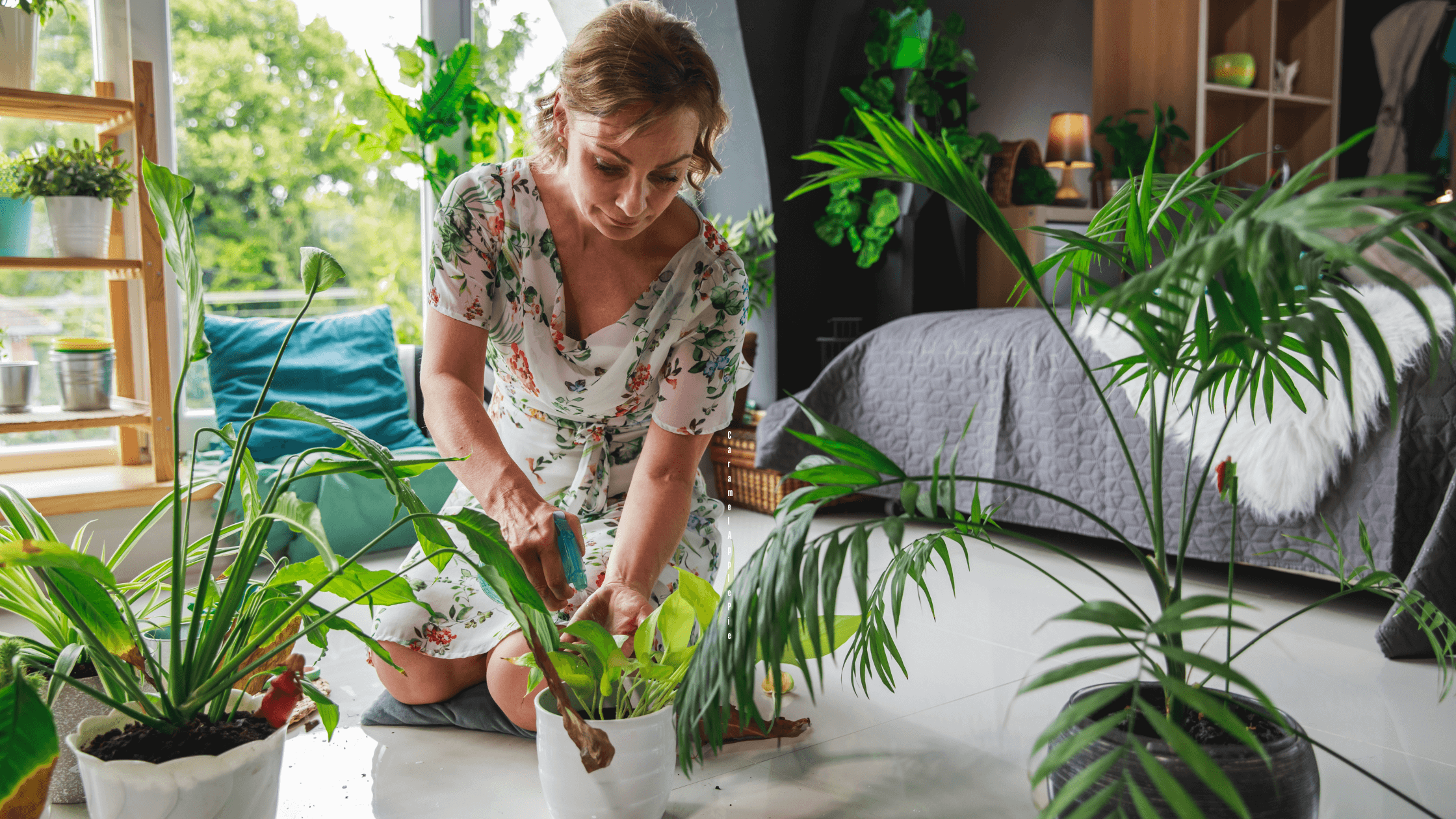Unlock Nature’s Magic: The Ultimate Guide to 10 Best Air-Purifying Houseplants for a Thriving Home
Discover the top air-purifying houseplants that not only enhance your living space aesthetically but also work tirelessly to cleanse and rejuvenate the air you breathe. Dive into a greener, healthier lifestyle today!
Houseplants have always been a popular choice for home decor, but did you know they offer so much more than just aesthetic appeal? Many houseplants have the incredible ability to purify the air in your home, making your living space not only more beautiful but also healthier. Let's dive into the world of air-purifying plants and discover which ones you should consider adding to your home.
Why Houseplants are Essential for a Healthy Home
Houseplants are nature's air purifiers. They absorb carbon dioxide and release oxygen, making our homes fresher and more breathable. But that's not all. Many houseplants can also filter out harmful toxins present in the air, such as Formaldehyde, Benzene, and Trichloroethylene. These toxins can come from everyday items like furniture, carpets, and paints. By introducing air-purifying plants into your home, you can reduce these toxins and breathe easier.
Top Air-Purifying Houseplants to Consider
1. Aloe Vera
Aloe Vera is often hailed as a miracle plant, and for good reason. Beyond its well-known medicinal properties, especially its ability to soothe burns and skin irritations, Aloe Vera is a formidable air purifier. Its succulent leaves are adept at absorbing airborne pollutants, especially benzene and formaldehyde. Ideally suited for sunny spots, this plant is a low-maintenance gem, requiring infrequent watering and minimal care, making it a favorite for both novice and seasoned plant enthusiasts.
2. Queen Fern
Queen Fern is the royalty of the fern family, especially when it comes to creating a healthier living environment. Its lush green fronds are not just a sight for sore eyes but also champions in purifying the air. The plant's preference for humid environments makes it an ideal choice for spaces like bathrooms or kitchens. And for those with pets, there's more good news: the Queen Fern is non-toxic to animals, ensuring that both your furry friends and your green companions can coexist in harmony.
3. Rubber Tree
The Rubber Tree is a testament to nature's beauty and functionality. Its dark, glossy leaves not only add a touch of elegance to any space but also work tirelessly to cleanse the air of pollutants. Native to Southeast Asia, this tree is a powerhouse when it comes to removing toxins like formaldehyde from the atmosphere. However, its beauty comes with a cautionary note: the leaves can be toxic if ingested, so it's essential to place them out of reach of pets and young children.
4. Snake Plant
Snake Plant, also known as the mother-in-law's tongue, is as intriguing as its name suggests. Its tall, upright leaves with vibrant green patterns are not just visually striking but also among the top air-purifying plants. What sets the Snake Plant apart is its unique ability to produce oxygen at night, unlike most plants that only do so during the day. This feature, combined with its low-maintenance nature, makes it a favorite for bedrooms and living spaces.
5. English Ivy
English Ivy, with its cascading vines and delicate leaves, is more than just a pretty face. This versatile plant is a formidable air purifier, known for its ability to reduce airborne mold and fecal particles. Its adaptability to various lighting conditions and easy-care nature makes it a popular choice for both homes and offices. Whether draped over a shelf or grown as a hanging plant, English Ivy is sure to enhance both the aesthetics and air quality of any space.
6. Weeping Fig Tree
The Weeping Fig Tree is a statement piece in every sense. Standing tall, often reaching up to 6 feet indoors, this tree is a visual delight with its slender trunk and canopy of drooping leaves. But its benefits aren't just aesthetic. The Weeping Fig is adept at filtering out common indoor pollutants, making the air in your home cleaner and fresher.
7. Bromeliad Vriesea Vogue
Bromeliad Vriesea Vogue is where functionality meets beauty. This tropical plant, with its vibrant bracts and foliage, is a visual treat. But beyond its aesthetic appeal, it's also an effective air purifier, known to remove harmful toxins from the environment. And for households with pets, this plant is a safe and colorful addition, posing no harm to your furry companions.
8. Red-Edged Dracaena
Red-Edged Dracaena is a testament to resilience and beauty. Its striking red-edged leaves are not just visually appealing but also efficient at filtering out pollutants like xylene and formaldehyde. The plant's ability to thrive in various lighting conditions and its low water requirements make it a favorite for those who seek both beauty and convenience.
9. Philodendron Heartleaf
Philodendron Heartleaf captures hearts with its charming, heart-shaped leaves. But its appeal goes beyond its appearance. This plant is a powerhouse when it comes to purifying indoor air, effectively removing toxins and creating a healthier living environment. Its trailing nature makes it perfect for hanging baskets or as a centerpiece on tables.
10. Peace Lily
Peace Lily is the epitome of elegance and functionality. Its glossy green leaves, complemented by its unique white blooms, make it a favorite for interior decor. But this plant does more than just look pretty. It's highly effective at removing common indoor pollutants like ammonia and benzene. However, while it brings peace to your living environment, it's essential to note that it can be toxic to pets, so it's crucial to place it out of their reach.
How Do Plants Purify the Air?
During photosynthesis, plants absorb carbon dioxide and release oxygen. This process not only provides us with the oxygen we breathe but also removes harmful toxins from the air. The larger the plant's leaves, the more surface area it has to purify the air. So, by adding a variety of plants with different leaf sizes and shapes, you can maximize the air-purifying benefits.
Buying Guide
When it comes to buying indoor plants that purify the air in your home, there are a few things to consider to ensure you get the best product for your needs. Here are some factors to keep in mind:
Plant Type
Different plants have different air-purifying properties, so it's important to choose the right type of plant for your home. Some popular options include:
- Spider plant: removes formaldehyde and xylene
- Peace lily: removes benzene, formaldehyde, and trichloroethylene
- English ivy: removes formaldehyde
- Snake plant: removes benzene, formaldehyde, trichloroethylene, and xylene
Size and Placement
Consider the size of the plant and where you plan to place it in your home. Larger plants will have a greater air-purifying effect, but you'll need to have enough space to accommodate them. Additionally, some plants may be better suited to certain rooms in your home based on their specific air-purifying properties.
Maintenance
Like any plant, indoor air-purifying plants require regular care and maintenance. Make sure you choose a plant that is easy to care for and fits your lifestyle. Some plants may require more sunlight or watering than others, so be sure to read up on the specific care requirements of any plant you're considering.
Price
Indoor air-purifying plants can vary in price depending on the type of plant and its size. Consider your budget and how much you're willing to spend before making a purchase. Keep in mind that larger plants may have a higher upfront cost, but they may also provide greater air-purifying benefits in the long run.
Overall, choosing the right indoor air-purifying plant for your home comes down to considering your specific needs and preferences. By keeping these factors in mind, you can find a plant that will help purify the air in your home and provide a natural, aesthetically pleasing touch to your decor.
Frequently Asked Questions
What are some of the top air purifying plants recommended by NASA?
NASA's Clean Air Study recommends several plants that are effective at removing indoor air pollutants. Some of the top air purifying plants include the spider plant, peace lily, snake plant, and bamboo palm.
Which indoor plants are the best for improving indoor air quality?
The best indoor plants for improving indoor air quality are those that are effective at removing common indoor pollutants such as formaldehyde, benzene, and trichloroethylene. Some of the best plants for this purpose include the snake plant, peace lily, spider plant, and bamboo palm.
What are some air purifying plants that are safe for cats?
Some air purifying plants that are safe for cats include the spider plant, Boston fern, and bamboo palm. It's important to note that while these plants are safe for cats, some cats may still be tempted to chew on them, so it's best to keep them out of reach.
How do indoor plants help purify the air in your home?
Indoor plants help purify the air in your home by absorbing harmful pollutants through their leaves and roots. They then convert these pollutants into harmless substances and release clean oxygen back into the air.
What are some of the benefits of having air purifying plants in your home?
Air purifying plants have several benefits, including improving indoor air quality, reducing the risk of respiratory problems, increasing productivity and concentration, and improving overall well-being.
What is the best way to care for indoor plants that purify the air?
The best way to care for indoor plants that purify the air is to provide them with the right amount of water, light, and nutrients. It's important to choose plants that are suitable for the lighting conditions in your home and to avoid overwatering or underwatering. Regularly dusting the leaves and occasionally fertilizing can also help keep your plants healthy.
In Conclusion
Houseplants are a fantastic way to improve the air quality in your home. Not only do they provide numerous health benefits, but they also add beauty and life to your living space. Whether you're a seasoned plant parent or just starting out, there's an air-purifying plant out there for you. So why wait? Start introducing these green wonders into your home today and breathe easier knowing you're making a healthier choice for you and your loved ones.
Master the Art of Watering: Unleash the Full Potential of Your Plants This Summer
10 Powerful Steps to Transform Your Living Space into a Cozy Retreat
How to Transform Your Backyard into a Cozy Outdoor Oasis





